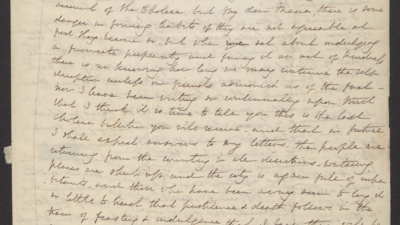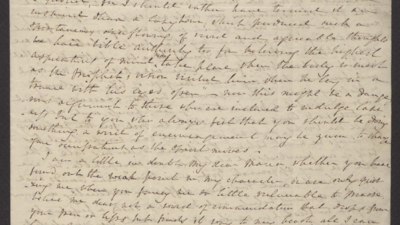Oral History Interview with Ellen Tarlow
Title
Date
Contributor
Summary
Ellen Tarlow, née Meinberg, was born in 1927 in Gütersloh, Westphalia, Germany, where her family had lived since the 17th century. Her father, Paul Meinberg, an importer of cattle, was decorated with the Iron Cross in WWI. She describes her early childhood in public school and then a Lyceum for girls. She first felt antisemitism at age of eight and was expelled from school in 1938. She studied Hebrew and Bible once a week. She details Nazi atrocities during and after Crystal Night (Kristallnacht): social ostracism, burning of their home and synagogue, her father’s deportation to and flight from Buchenwald. Remaining family found shelter in a local cloister then fled to Bielefeld. She describes subsequent life in a Judenhaus in Gütersloh, including attempts to educate the children there. HIAS helped the family many times; there was also aid from several Germans in Gütersloh. She briefly mentions a failed attempt to emigrate to Haiti. After many disappointments and a difficult experience at the American Consulate in Stuttgart, the family left Germany for the United States, via Lisbon, Portugal, on the SS Mouzinho, in August 1941. She describes the journey from Berlin to Lisbon in a sealed train, and her stay in Lisbon in a group home run by HIAS. She describes how refugees organized to cope with primitive conditions on the ship, her arrival and processing in Staten Island, NY, and her life in New York in a group home for refugees sponsored by HIAS. She reflects at length on the family’s adjustment in the United States and the survivor’s guilt she feels. She talks about her return to Germany, by invitation, in 1985, accompanied by her husband and daughter.
none
More Sources Like This
of
Arthur Goldstein
Arthur Goldstein served in the 80th Infantry Division, 305th Medical Battalion during World War II. He mentions encountering an Italian priest who had been tortured and prisoners of war left behind by German soldiers, including Colonel Hallen, a war correspondent who had been mistreated.
When Mr. Goldstein liberated Dachau Concentration camp he found piles of corpses scattered throughout the camp, mass graves, charred remains of civilians tied to railroad tracks who were burned to death, and evidence that many prisoners were obviously killed just prior to liberation. He went inside a room full of ovens as well as a gas chamber. He saw a few surviving inmates stoning a German guard. Other inmates described atrocities committed by the guards. His medical unit fed and cared for the approximately 50 survivors and evacuated them to the base hospital. Sometime after leaving Dachau, he found several hundred women, imprisoned in a barn, who had been used as sex slaves by German soldiers. He mentions showing pictures he took of the bodies at Dachau to German-Americans, some of whom denied that this actually happened.
of
Hyman Blady
Hyman Blady was born February 11, 1920 in Warsaw to a middle class Zionist family; he belonged to HaShomer HaTzair. His father owned a shoe store. He discusses pre-war Poland, his education, and antisemitism in Poland.Hyman’s family was forced into the Warsaw Ghetto in 1939. A Christian friend helped him get some supplies out of his family’s shoe store to make shoes in the ghetto. Hyman also gives numerous of examples of Poles smuggling into the ghetto to buy Jewish wares at unreasonably low prices and describes how Jews managed to survive.
He escaped from the ghetto for a time passing as an Aryan, but returned to care for his younger brother when his mother died. Hegives a detailed description of the liquidation of the Warsaw Ghetto in 1942. After hiding in the ghetto, he and his brother are eventually found and sent to Bobruisk concentration camp for more than a year. Hyman worked as a shoemaker. His very young brother survived because a German soldier took pity on him when he was selected to die and made him his shoe polisher. Hyman worked as a shoemaker in several camps which he describes in detail. He and his brother were deported to Blizyn (for eight months), then Hyman was separated from his brother when he was deported to Plaszow (for six months) where he did saddlework. He describes the relatively improved conditions there.
In 1944, Hymanwas deported to Mauthausen and then theGusen subcamp where he worked underground building a factory for Messerschmidt airplanes for the Germans. He describes the deplorable conditions, selections, and scarcity of food. He details the horrible conditions during a deportation to get deloused in Linz, Austria. Many perished in a sealed cattle car and train cars were bombed by the Allies while there. Hyman describes being sent back to Gusen and then again to Mauthausen from which they were taken on a death march to Gunskirchen where they were scheduled to be killed. Hyman was liberated by Americans May 4 or 5, 1945. He and a group of boys went to a farm not far from Wels. He got ill eating too much food too quickly and was taken to a hospital in Lambach (Austria) for 2 weeks, but insisted on returning to his eight friends. After a time all refugees were forced to a DP camp near Wels. Subsequently, they travelled to Föhrenwald DP camp and he was eventually reunited with his brother who had survived Auschwitz. Hyman married in 1946. After their planned emigration was delayed because of the Exodus, they stayed in Germany, had a son, eventually emigrating to the United States sometime before 1950. Hyman attributes his survival to his sheer will to live and luck.
of
Julius Eingorn
Dr. Julius Eingorn served with the 79th Infantry Division, U.S. 3rd Army in a special 12 unit dispensary that liberated Ohrdruf, April 1945. There were no survivors. He describes what he saw there, including evidence of primitive cremations, and prisoners marched out of Ohrdruf and killed just before liberation. He mentions General Eisenhower’s orders that all service men had to tour the camp.
In May, 1945 his unit entered an unnamed labor camp near either Weida or Werdau, Germany. He spoke with many of the 150 surviving Jewish Hungarian girls in Yiddish. They all told him that their choice had been either to stay with their mothers and be exterminated or work in the camp. Whoever got sick was killed. He also stopped at a German hospital for Polish and Russian prisoners and discovered that out of 1500 patients only 400 survived. His unit liberated British Prisoners of War. He encountered streams of German refugees fleeing the Russian army and mentions accepting the surrender of whole German divisions. He interviewed many people around Ohrdruf who all felt no guilt and pleaded total ignorance of what happened there. Dr. Eingorn reflects on what he saw during the war and the need for constant vigilance to prevent another Holocaust.
of
K. R. Anonymous
K. R. was born in Tarnopol, Poland, March 31, 1922. Her father was a businessman and her family was greatly influenced by Viennese culture. She briefly describes the start of overt antisemitism in her schools. She was a member of HanoarHatzioni and active in Zionist youth groups in Tarnopol and L’vov.
In 1940, under Russian Occupation, she and a group of HanoarHatzioni members were caught by some Ukrainian villagers—as they tried to cross the border illegally—and delivered to police. K. R. was sent to prison and later transferred to a labor camp near the North Pole. She describes the harsh conditions in the camp and why some of her fellow prisoners did not survive. She was released because she was Polish but given Soviet citizenship and sent by train to another part of Russia. Many strangers helped her during this time. She worked as a bookkeeper at a collective farm (kolkhoz) near the Russian village Devochki Gorki on the Volga River. When the German Army advanced, she was deported to Kazakhstan by train. She describes the conditions under which she lived. She worked as a bookkeeper in Kustanay. After the NKVD tried to recruit her as a spy, she fled to Alma Ata using documents she forged.
In 1945, after the war, she returned to Tarnopol and found it almost completely destroyed. She joined a kibbutz in Lodz and worked with HashomerHatzair to prepare young Russian refugees for life in Palestine. She also organized and led illegal border crossings to get them there. During this time she met and married her husband. They went to Palestine, from Cyprus, on a ship called The State of Israel in 1948, escorting a group of young Jewish children who had been hidden in monasteries or by Polish families. K. R. then reflects about how her experiences have shaped her outlook on life and her views about human behavior.

